Excerpts from Jim Conrad's
Naturalist Newsletter
from the December 6, 2015 Newsletter issued from Hacienda Chichen Resort beside Chichén Itzá Ruins, central Yucatán, MÉXICO
SNOW SQUARESTEM
Some of the least presuming, downright homely looking plants turn out to be -- when you take the time to pay attention -- very interesting and pretty. That's the case with the leggy, gangly weed growing beside the road between Pisté and Xcalacoop shown below:
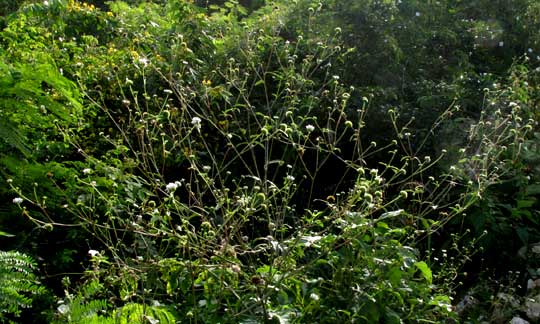
Up close, the plant takes on a little character with its leaves, the larger ones all clustered at the plant's base, bearing saw-toothed margins and one or two spreading lobes at their bases, as shown below:

What appear to be white flowers at a distance, up close prove to be mothball-size heads consisting of many tiny, white, cylindrical flowers, or florets, each mature floret topped with two style arms curving up and out of the corolla, like bull horns, as seen below:
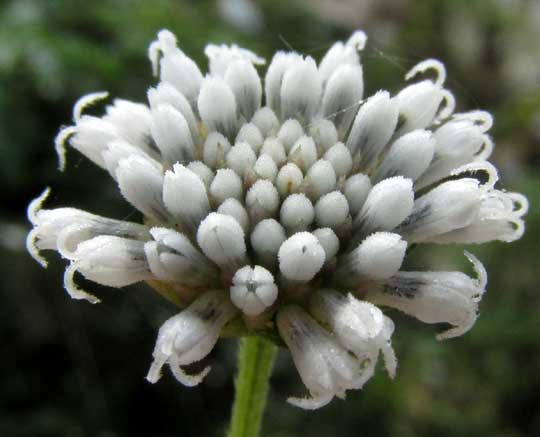
This manner of packing tiny florets into a head tells us that we're dealing with a member of the Composite or Daisy Family, the Asteraceae. Once we realize that, and remember that the Composite Family is one of the two or three most species-rich of all plant families, and that figuring out the species can be hard, we know we need to start paying attention to details.
The first big field mark to note is that the florets in this species are all of the cylindrical "disc flower" type -- no ray flowers. Most Composite Family species have both disc and ray types, such as asters, and many produce only ray types, such as dandelions, so already we know we're dealing with that minority of Composite Family members whose flowering heads bear only disc flowers.
Another important field mark needed for Composite Family identification usually is the shape and configuration of the green, cup-like " involucres" below the cluster of florets, involucres being composed of modified leaves called phyllaries, which usually are triangular, sharp-pointed and arranged into one to several series, as shown here:
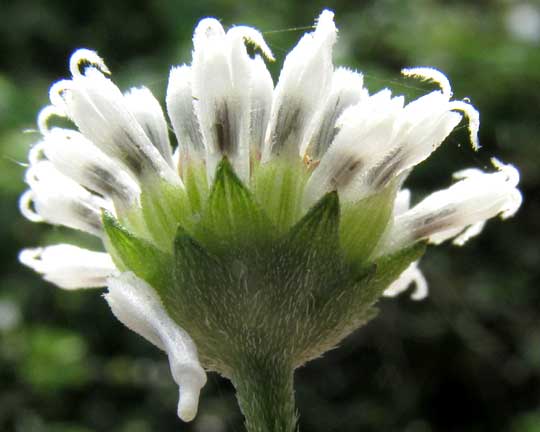
In that picture, the involucre is more or less "normal," but it's worth noting that inside the corolla tubes there are black anthers; most anthers are yellowish, like pollen. More important field marks are shown in a broken-open head in which the corollas have fallen off and the florets' ovaries have developed into hard, dark, cypsela-type fruits, seen below:
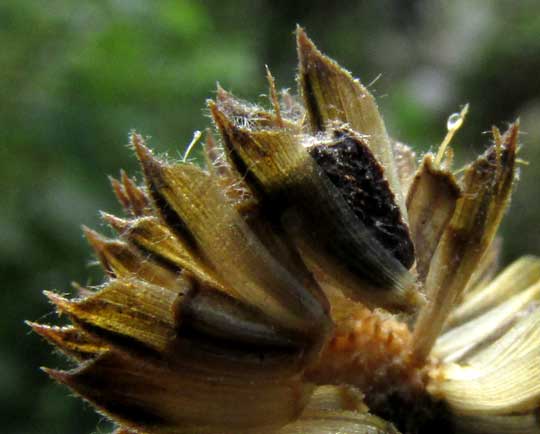
First it's important to note that between each sunflower-seed-like fruit there's a papery, pale brown, fingernail-like structure partially enveloping the fruit. Those are "paleae," and in the Composite Family thousands of species produce flowers with them, while thousands lack them, so this is one of the fundamental things we need to know. Another important field mark is that the cypselae fruits aren't topped with white hairs as dandelion and aster cypselae are, nor with permanent spines like those of Spanish-needles or Stick-tights.
We've already seen enough to figure out this plant, but one more nice detail worth showing is that once all its cypselae have fallen away, the papery paleae subtending the head spread out, making what looks like a handsome little flower with many whitish petals, as seen below:
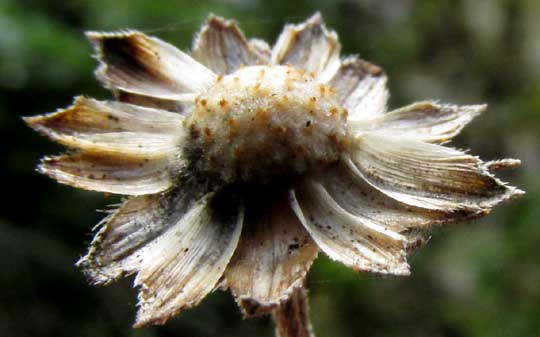
This is MELANTHERA NIVEA, distributed from the US southeastern states south through Mexico, Central America and the Caribbean to Brazil in South America. Occurring in the US, it's been bestowed with the English name Snow Squarestem. In Spanish it's often less elegantly known as Yerba de Cabra, or Goat-plant.
Despite its homeliness, gardeners in the southern US are beginning to esteem Snow Squarestem. An information sheet available online from the Florida Native Plant Society describes the plant as a must for any butterfly garden because of the copious nectar it supplies to pollinators, plus its herbage hosts caterpillars of certain butterfly species. "This species will keep your garden humming," they write.